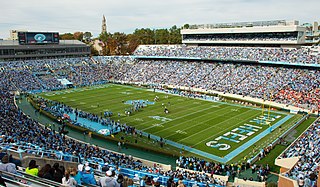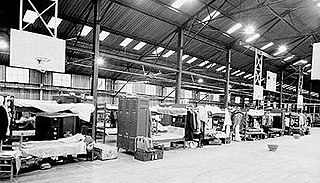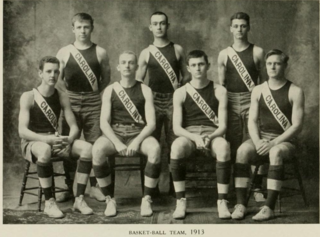
Kenan Stadium is a college football stadium located on Stadium Drive in Chapel Hill, North Carolina. Opened in 1927, it is home to the University of North Carolina at Chapel Hill's (UNC) football team, which competes in the Atlantic Coast Conference. The facility replaced Emerson Field, where the school's football program had been based since 1916. Plans for the stadium began as attendance increased. Ground was broken on the stadium in December 1926 and work completed in August 1927. The stadium hosted its first game on November 12, 1927, when the Tar Heels faced the Davidson Wildcats, where the Tar Heels won 27–0 in front of 9,000 spectators. On November 24, 1927, the stadium was officially opened and dedicated during a game where the Tar Heels hosted the Virginia Cavaliers and won 14–13.

The Dean E. Smith Student Activities Center is a multi-purpose arena in Chapel Hill, North Carolina, used primarily as the home for the University of North Carolina at Chapel Hill Tar Heels men's basketball team. The university began to inquire about building a standalone arena for the men's basketball team beginning in the mid-1970s, but due to an ongoing university wide investigation, the fundraiser halted until its conclusion. In June 1980, the fundraising began with a goal of at least $30 million and a target completion date for the building of December 1984. It was initially planned to be called the Student Activities Center; however, after its announcement it began to be referred to as The Dean Dome and it was speculated it would be named for then coach Dean Smith. The fundraising concluded in August 1984 with over $33 million raised, but construction would not be finished until 1986. The day before the opening game on January 18, 1986, against the Duke Blue Devils, the building was officially announced to be named the Dean E. Smith Student Activities Center, while a formal dedication happen later in September. In 2018, the hardwood floor of the Smith Center was named for then coach Roy Williams.

William Donald Carmichael Jr. Arena is a multi-purpose arena on the campus of the University of North Carolina at Chapel Hill in Chapel Hill, North Carolina, United States. It is home to four Tar Heels athletic teams: women's basketball, volleyball, women's gymnastics, and wrestling. It is named for William Donald Carmichael Jr., a popular former school vice-president and brother of All-America basketball player Cartwright Carmichael.

The Indoor Athletic Court was the home of North Carolina Tar Heels men's basketball team from January 8, 1924, through February 17, 1938, across fifteen seasons. Due to increased demand for viewing the varsity basketball team and limited capacity at then home court Bynum Gymnasium, the university appropriated $54,482.45 to have a structure built to house the team. Then Graduate Manager of Athletics Charles T. Woollen decided to build a temporary structure with those funds and a more permanent venue later. Plans were purchased and work began in October 1923. The building, which was a completely steel structure, was built with galvanized steel sheet siding and roof. Many felt the building did not have an attractive exterior. The building featured one bathroom, no locker or dressing rooms, and no heating system, initially. Quickly the building earned a reputation for being cold during the winter and hot during the summer time. An official heating system and, later individual heaters, were added to the building, but did not help the temperature problem. The men's basketball team moved to the Woollen Gymnasium in 1939.

The Dixie Classic was an annual college basketball tournament played from 1949 to 1960 in Reynolds Coliseum. The field consisted of the "Big Four" North Carolina schools, the host NC State Wolfpack, Duke Blue Devils, North Carolina Tar Heels, and Wake Forest Demon Deacons, and four teams from across the country.

Rameses is the ram mascot of the North Carolina Tar Heels. The anthropomorphic version of him wears a Tar Heels jersey. Two versions of Rameses appear at UNC sporting events. One is a member of the UNC cheerleading team in an anthropomorphic ram costume; the other is a live Dorset Horn sheep named Rameses who attends Carolina football games with his horns painted Carolina blue. There is a third UNC mascot; another anthropomorphic ram, Rameses Jr., or RJ for short.

Bynum Hall is the current home of the University of North Carolina at Chapel Hill Graduate Admissions office and was the first home of North Carolina Tar Heels men's basketball team. At an executive meeting on October 2, 1903, school President Francis Preston Venable announced that former North Carolina Supreme Court justice William Preston Bynum donated $25,000 to have a gymnasium built in honor of his grandson who was a student at the university and had died due to typhoid fever. Architect Frank P. Milburn drafted plans for the structure, which were then approved by Bynum and the university's board of trustees. The building was designed to have a Greek architecture influence and had three stories with an above-ground basement. It originally contained a swimming pool, gymnasium, office spaces, and other rooms for various sports like boxing and fencing. The building started construction by June 1904 and was completed by February 1905.

The 1956–57 North Carolina Tar Heels men's basketball team was the varsity college basketball team that represented the University of North Carolina. The head coach was Frank McGuire. The team played its home games at Woollen Gymnasium in Chapel Hill, North Carolina, and was a member of the Atlantic Coast Conference. The team was the second undefeated national champion in NCAA basketball history and was the first ACC team to win a title. The team notably won its last two games in triple overtime. The Tar Heels leading scorer was player of the year, small forward Lennie Rosenbluth.

The 1923–24 North Carolina Tar Heels men's basketball team was the fourteenth varsity college basketball team to represent the University of North Carolina (UNC) as a part of the Southern Conference (SoCon) for the NCAA season. The team went undefeated, and the season was the first played in the Tin Can. The head coach was Norman Shepard, coaching in his first and only season with the Tar Heels. Their fast play and defense won them the 1924 Southern Conference men's basketball tournament.
The 1929 North Carolina Tar Heels football team represented the University of North Carolina during the 1929 college football season as a member of the Southern Conference (SoCon). The Tar Heels were led by head coach Chuck Collins in his fourth season and finished with a record of nine wins and one loss. The team scored a total of 346 points.
The 1930 North Carolina Tar Heels football team was an American football team that represented the University of North Carolina as a member of the Southern Conference during the 1930 college football season. In their fifth season under head coach Chuck Collins, North Carolina compiled an 5–3–2 record.
The 1955 North Carolina Tar Heels football team represented the University of North Carolina at Chapel Hill during the 1955 college football season. The Tar Heels were led by third-year head coach George T. Barclay, and played their home games at Kenan Memorial Stadium. The team competed as a member of the Atlantic Coast Conference, finishing in fifth.

Robert Allison Fetzer Hall is a multi-purpose sport venue on the campus of University of North Carolina at Chapel Hill in Chapel Hill, North Carolina, United States. The building hosts several sport courts. The Fetzer Gyms A and B are used for basketball, volleyball, badminton and team handball.
The 1938 North Carolina Tar Heels football team represented the University of North Carolina at Chapel Hill during the 1938 college football season. The Tar Heels were led by third-year head coach Raymond Wolf and played their home games at Kenan Memorial Stadium. They competed as a member of the Southern Conference.
The 1936 North Carolina Tar Heels football team represented the University of North Carolina at Chapel Hill during the 1936 college football season. The Tar Heels were led by first-year head coach Raymond Wolf and played their home games at Kenan Memorial Stadium. They competed as a member of the Southern Conference.

The 1910–11 North Carolina Tar Heels men's basketball team was the first varsity college basketball team to represent the University of North Carolina. The school created a committee to determine if the school should go forward with forming a team as there was increasing pressure from students, the student run newspaper The Tar Heel, in-state schools that fielded teams who wanted to form a state league, and the University of Tennessee inquired about scheduling a game in February 1911. Equipment was purchased and installed at Bynum Gymnasium after a period of uncertainty of where the team would play its home games. Then track-and-field head coach Nathaniel Cartmell – who had little experience with basketball – was chosen to coach as there were no funds to be allocated for hiring another coach. After choosing players for the first team, Cartmell finalized the schedule in January, which was limited as many other programs had already created their schedules before the Tar Heels made their team.

The 1911–12 North Carolina Tar Heels men's basketball team was the second varsity college basketball team to represent the University of North Carolina. After the first season, it was announced that star player and captain Marvin Ritch was named manager for the upcoming year's team. He assumed scheduling duties and released a tentative schedule in December. Newspaper outlets deemed it to be one of the toughest schedules to be played. However, before the start of the semester and college basketball season, Ritch left the team to work as a secretary for Congressman Edwin Y. Webb.

The 1912–13 North Carolina Tar Heels men's basketball team was the third varsity college basketball team to represent the University of North Carolina. In September, Lenoir Chambers was announced team captain. North Carolina, along with several other schools from the state, met in Raleigh, North Carolina and formed the North Carolina Intercollegiate Basketball Association that would establish a state championship where each school in the league would play two games against all other members and the team with the best record was the champion. However, the league did not come to fruition partially because Trinity College's professors did not want to have athletic contests with North Carolina. Student–run newspaper The Tar Heel published several pieces where they stated the prior season's poor performance was because the team did not start practicing until after Christmas. Try-outs started in early December, but over time participating students dwindled and scrimmaging became difficult, which prompted Chambers to publish in ad in the student newspaper asking for taller players to come by regardless of their experience.

The 1913–14 North Carolina Tar Heels men's basketball team was the fourth varsity college basketball team to represent the University of North Carolina.

The 1916–17 North Carolina Tar Heels men's basketball team was the seventh varsity college basketball team to represent the University of North Carolina.

















